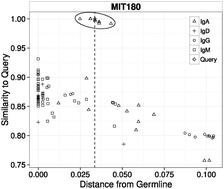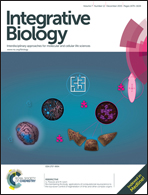Neutralizing antibodies against West Nile virus identified directly from human B cells by single-cell analysis and next generation sequencing†
Abstract
West Nile virus (WNV) infection is an emerging mosquito-borne disease that can lead to severe neurological illness and currently has no available treatment or vaccine. Using microengraving, an integrated single-cell analysis method, we analyzed a cohort of subjects infected with WNV – recently infected and post-convalescent subjects – and efficiently identified four novel WNV neutralizing antibodies. We also assessed the humoral response to WNV on a single-cell and repertoire level by integrating next generation sequencing (NGS) into our analysis. The results from single-cell analysis indicate persistence of WNV-specific memory B cells and antibody-secreting cells in post-convalescent subjects. These cells exhibited class-switched antibody isotypes. Furthermore, the results suggest that the antibody response itself does not predict the clinical severity of the disease (asymptomatic or symptomatic). Using the nucleotide coding sequences for WNV-specific antibodies derived from single cells, we revealed the ontogeny of expanded WNV-specific clones in the repertoires of recently infected subjects through NGS and bioinformatic analysis. This analysis also indicated that the humoral response to WNV did not depend on an anamnestic response, due to an unlikely previous exposure to the virus. The innovative and integrative approach presented here to analyze the evolution of neutralizing antibodies from natural infection on a single-cell and repertoire level can also be applied to vaccine studies, and could potentially aid the development of therapeutic antibodies and our basic understanding of other infectious diseases.


 Please wait while we load your content...
Please wait while we load your content...